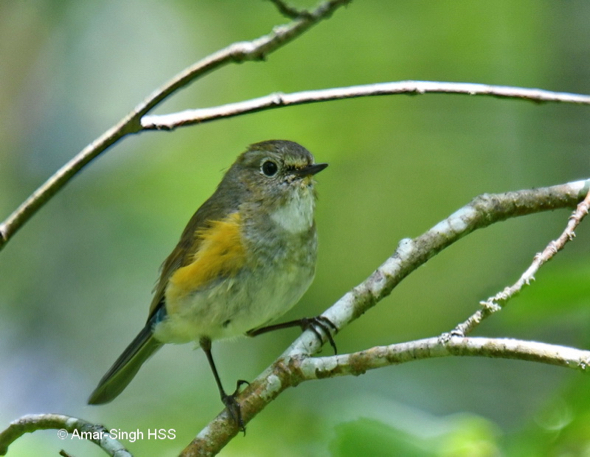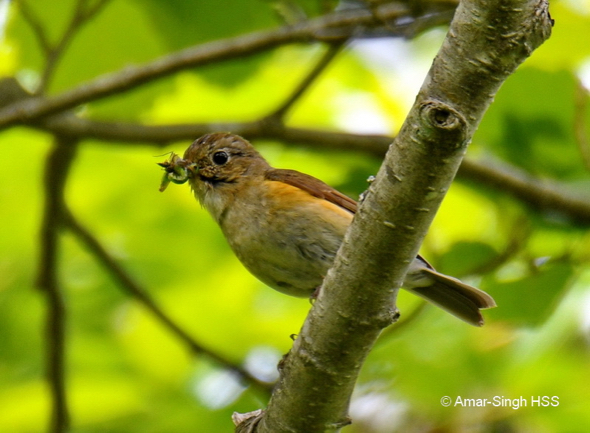“This will be a lengthy post. We saw quite a number of Red-flanked Bluetail (Tarsiger cyanurus) aka Orange-flanked Bush-robin, and some were breeding. I am using this bird to discuss terminology used for aging birds. I will start by quoting two individuals:
“Firstly Keith Vinicombe (The Helm Guide to Bird Identification. Bloomsbury. 2014) who says:
‘At this point, it is essential to clarify one particular area of confusion. Any bird to that is not mature (i.e. not an adult) is an ‘immature’. Literally ‘immature’ simply means ‘not mature’. Thus, a juvenile bird is an immature, as is a first-winter, a second-summer and so on. The term ‘juvenile’ should be confined to a bird’s very first plumage worn for a short time after leaving the nest. Although many larger birds migrate whilst still in juvenile plumage, most passerines do not. …If these birds are not adults, then they are ‘first-winters’. Similarly, subadult is also to be avoided if possible, as again more accurate ageing can usually be determined.’“Secondly our OBI Editor Krys Kazmierczak who writes:
‘There is sometimes a little confusion regarding the ageing of birds and how we describe the different age classes of birds. I hope the following summary of how we apply the terminology to different ages of birds on Oriental Bird Images may help. This is based on the terminology in common use in Europe and Asia. Note that there is a different system commonly used in the Americas. Beginning with the youngest:
1. Egg
2. Hatchling – a bird which has just emerged from its egg
3. Chick – a young bird not yet able to fly.
4. Fledgling – a young bird that has just developed the feathers necessary for flying, e.g. just taken its first flight.
5. Juvenile – a bird in its first full set of feathers, in many species quite different to the adult plumage attained after a complete post-juvenile moult. This phase may last quite a short time in some species, but quite a long time in species such as raptors.
6. 1st winter – in some species a partial post-juvenile moult in autumn results in a plumage which is distinguishable from juvenile but is clearly not yet adult.
7. Immature – an intermediate plumage that is clearly no longer completely juvenile, but is clearly not yet adult. (Sometimes also used to describe any bird that is not yet adult, i.e. includes juvenile.)
8. Subadult – a bird which is almost fully adult but which still shows some, usually small, traces of immature plumage.
9. Adult – A bird in its final full plumage. In some species one can also distinguish between a non-breeding (winter) adult plumage and a breeding (summer) adult plumage.’“Both have more to say about the issue but I have quote the key sections. I have chosen to quote them as I want to set a ‘bench-mark’ for the discussion.
“My question, when I watched these Red-flanked Bluetails, is ‘when is a bird an adult’?
“This could also be a question we ask of our children/teenagers/young adults. Is a bird an adult when it attains is ‘adult’ plumage (breeding or non-breeding plumage)? Or can we also accept that a bird that has yet to attain adult plumage but is already breeding is an adult?
“We saw a pair of Red-flanked Bluetails that were breeding but both were not in adult plumage. Peter Clement & Chris Rose (Robins and Chats. Helm Identification Guides. 2015) state about Red-flanked Bluetails that ‘Some birds sing and breed while still having brown head and upperparts or first-year plumage” and “males breed in first year’. Clement & Rose go on to use terms uncommon to me: ‘first-adult male’ and ‘first-adult female’.
“So on to our observations:
“The images at top and above are of the same breeding male that has first year plumage (first summer male aka a first-adult male). Difficult at time to distinguishing from a female and one key feature is the bright orange flanks (Clement & Rose 2015).
“Images above and below are of the same breeding female that has first year plumage (first-adult female). Clement & Rose say that the distinguishing feature from an adult female is the pointed, not rounded tips to tail feathers (seen in the image below).
“So do we consider these two breeding birds adults?
“Note: Some of the birds in the OBI database listed as ‘first winter male’ might be ‘first summer or second winter males.’”
Dato’ Dr Amar-Singh HSS
Ipoh, Perak, Malaysia
6th June 2019Location: East Hokkaido, Japan












